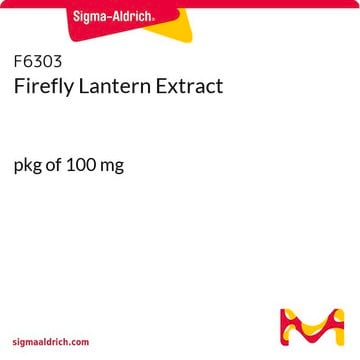SRE0045
Luciferase from Photinus pyralis (firefly)
recombinant, expressed in E. coli, lyophilized powder, ≥10×1010 units/mg protein
Synonym(s):
Luciferase firefly
Sign Into View Organizational & Contract Pricing
All Photos(3)
About This Item
CAS Number:
MDL number:
UNSPSC Code:
12352204
NACRES:
NA.54
Recommended Products
recombinant
expressed in E. coli
Quality Level
form
lyophilized powder
specific activity
≥10×1010 units/mg protein
mol wt
62 kDa
application(s)
diagnostic assay manufacturing
storage temp.
−20°C
Looking for similar products? Visit Product Comparison Guide
Application
Firefly luciferase is used extensively in molecular and cell biology, in particular for the efficient detection and quantitation of ATP and as a reporter for genetic function.
Biochem/physiol Actions
Firefly luciferase is a 62 kDa protein that catalyzes the production of light. The enzyme requires ATP, molecular oxygen, and the heterocyclic compound, firefly luciferin, to generate light in a two-step process. The light producing reaction is initiated by luciferin activation (adenylation of its carboxylate group) and proceeds in the presence of molecular oxygen to yield a photon of yellow-green light.
Unit Definition
One luciferase enzyme unit will produce one Relative Light Unit (RLU) at 20-25 °C over a 10 second period, measured in 100 μl assay mixture containing 40 pmol ATP and 15 nmol luciferin in Tris-glycine buffer, pH 7.6, using a GloMax 20/20 Luminometer.
Unit Definition Conversion Factor: There are approximately 9000 Relative Light Units (RLU) per one traditional Light Unit that uses a peak height equivalent to 0.02 μCi of 14C in a PPO/POPOP cocktail.
Unit Definition Conversion Factor: There are approximately 9000 Relative Light Units (RLU) per one traditional Light Unit that uses a peak height equivalent to 0.02 μCi of 14C in a PPO/POPOP cocktail.
Physical form
Supplied as a lyophilized powder containing HEPES, pH 7.5, NaCl, MgCl2, EDTA, DTT and a carbohydrate stabilizer.
This product is a recombinant luciferase (62 kDa) from Photinus pyralis (American firefly) produced from the luc gene expressed in E. coli.
Preparation Note
To obtain maximal solubility it is important to reconstitute the enzyme at a high salt concentration, such as 1 M Tris buffer with any counter ion at pH 7-8. The enzyme can be prepared at a concentration of up to 5 mg protein/ml. Do not vortex and avoid agitation.
After reconstitution, the enzyme solutions can kept at 4-8 °C for up to 2 days or frozen in working aliquots at -20°C for at least one month. Repeated freezing and thawing is not recommended.
After reconstitution, the enzyme solutions can kept at 4-8 °C for up to 2 days or frozen in working aliquots at -20°C for at least one month. Repeated freezing and thawing is not recommended.
substrate
Signal Word
Danger
Hazard Statements
Precautionary Statements
Hazard Classifications
Eye Dam. 1 - Resp. Sens. 1
Storage Class Code
11 - Combustible Solids
WGK
WGK 3
Flash Point(F)
Not applicable
Flash Point(C)
Not applicable
Certificates of Analysis (COA)
Search for Certificates of Analysis (COA) by entering the products Lot/Batch Number. Lot and Batch Numbers can be found on a product’s label following the words ‘Lot’ or ‘Batch’.
Already Own This Product?
Find documentation for the products that you have recently purchased in the Document Library.
Customers Also Viewed
Maura Greiser et al.
eLife, 12 (2023-06-05)
Mitochondrial ATP production in ventricular cardiomyocytes must be continually adjusted to rapidly replenish the ATP consumed by the working heart. Two systems are known to be critical in this regulation: mitochondrial matrix Ca2+ ([Ca2+]m) and blood flow that is tuned
Julia Adelöf et al.
Aging cell, 20(4), e13336-e13336 (2021-03-16)
With age, protein damage accumulates and increases the risk of age-related diseases. The proteasome activator PA28αβ is involved in protein damage clearance during early embryogenesis and has demonstrated protective effects against proteinopathy. We have recently discovered that adult female mice
Aleksey Yevtodiyenko et al.
Nature communications, 12(1), 2680-2680 (2021-05-13)
Bioluminescent imaging (BLI) is one of the most powerful and widely used preclinical imaging modalities. However, the current technology relies on the use of transgenic luciferase-expressing cells and animals and therefore can only be applied to a limited number of
S R Ford et al.
Journal of bioluminescence and chemiluminescence, 7(3), 185-193 (1992-07-01)
Commercially available crystalline native and recombinant firefly luciferases were compared. The two types of luciferase had indistinguishable responses to variation in ATP and luciferin concentrations and to omission of reaction components. The time courses of light production, the responses to
Kanika Narula et al.
The Plant journal : for cell and molecular biology, 103(2), 561-583 (2020-03-15)
Pathogen-/microbe-associated molecular patterns (PAMPs/MAMPs) initiate complex defense responses by reorganizing the biomolecular dynamics of the host cellular machinery. The extracellular matrix (ECM) acts as a physical scaffold that prevents recognition and entry of phytopathogens, while guard cells perceive and integrate
Our team of scientists has experience in all areas of research including Life Science, Material Science, Chemical Synthesis, Chromatography, Analytical and many others.
Contact Technical Service











